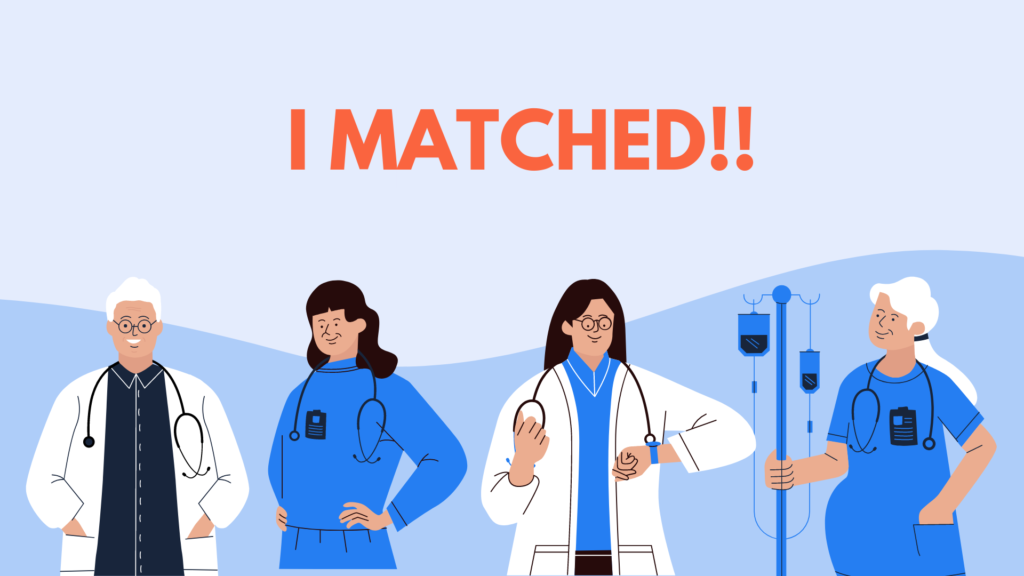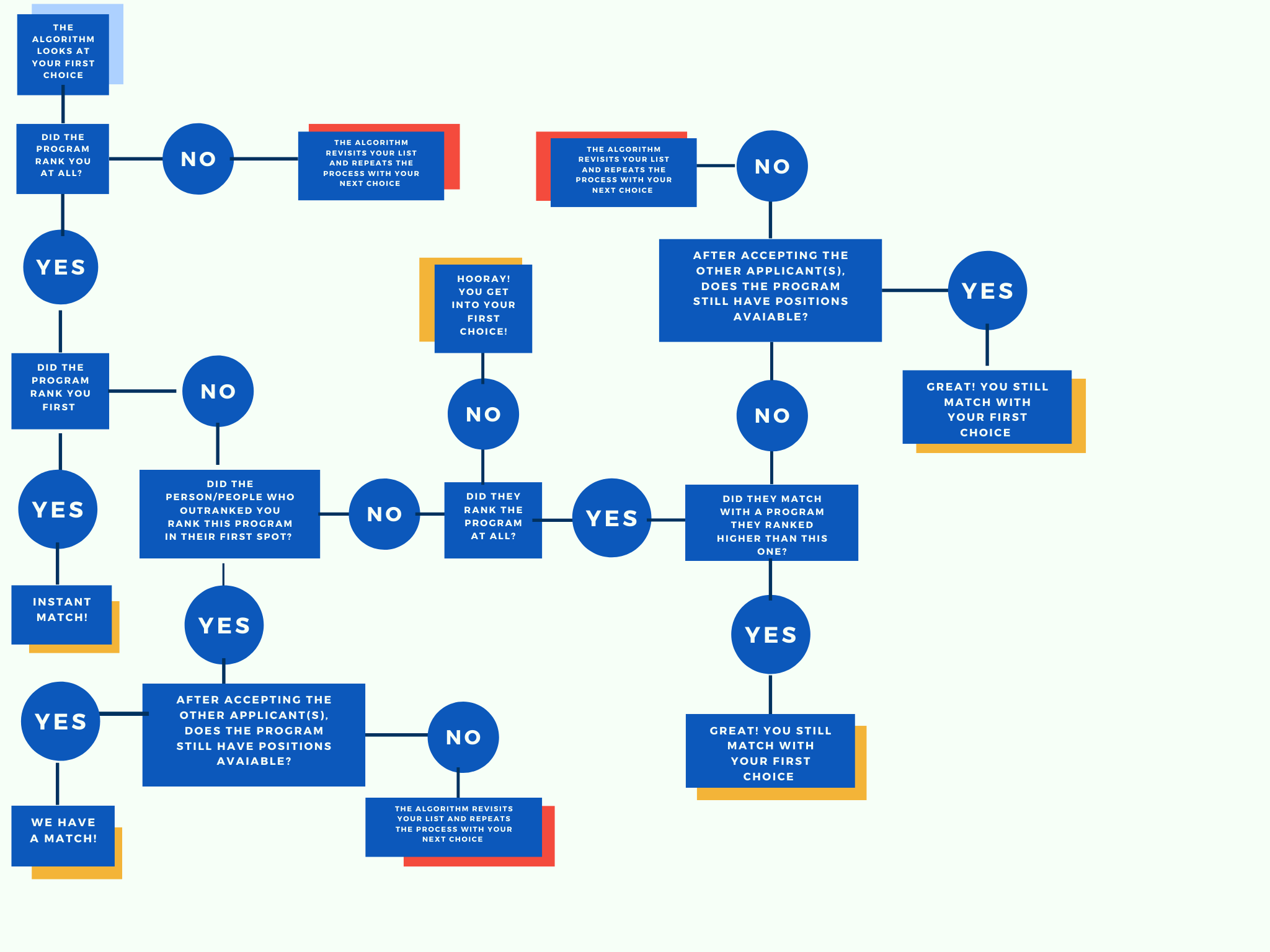Advice
Tags

CaRMS Match Algorithm & Best Practices
We’ve talked about how to write an effective personal statement. We’ve talked about how to prepare for your residency interviews. Now, it’s time to talk about the next step in the residency application process: putting together your rank order list (ROL)!
Ranking opens on CaRMS Online on March 7th 2022 – roughly a week into the national interview period. The deadline to submit your ROL is March 31st which gives you just over three weeks to finalize your lists, depending on when your interviews are held. The next step is for the algorithm to work its magic and match applicants with their listed programs. You’ll discover the algorithm’s results on CaRMS’ Match Day, the exciting day when match results are made available through your CaRMS Online account.
You may have heard that the algorithm favours applicants’ ROLs. But what does that really mean? Is it better to rank programs that you think you have a shot at or programs that you actually want to train at? Does the algorithm treat applicants differently based on the country they graduated from?
In this week’s blog post, we’ll discuss how the match algorithm works, best practices for putting your ROL together, and we’ll even get into CaRMS’ match statistics from last year.
Ready? Great, let’s get into it!
The Algorithm
There are three pieces of information that the algorithm needs to function:
- Your ROL
- Your programs’ ROLs
- The number of available training positions at each program
The algorithm takes applicants’ ROLs into consideration before it does any of the programs’ preferences. Essentially, it starts with your top rated program, checks if that program ranked you, and whether or not the program has already filled all of its available positions. It works this way regardless of whether you are a Canadian medical graduate (CMG), an international medical graduate (IMG) or a U.S. medical graduate (USMG).
The most straightforward (and the best case) scenario is if your highest ranked program also ranked you as their first choice. BAM! That gives you an instant match. But there are often more complicated scenarios that need to be taken into consideration.
Here’s a flowchart to explain how the algorithm works in more detail:

Book a Free Consultation Today!
Free ConsultationAre you and your partner both applying to residency this year? You could actually apply as a couple! In this case, you would both submit your ROLs individually but the algorithm would treat them as a single unit. This process is known as the CaRMS couples match. You don’t need to both apply to the same programs or rank them the same. It’s basically saying “If my partner attends this program, I would attend that program.”
If you submit your ROL as a couple, your lists might look a little like this:
Partner 1 | Partner 2 |
Program C | Program A |
Program F | Program B |
Program B | Program D |
Program E | Program C |
Program K | No Match |
No Match | Program F |
You even have the option of listing programs multiple times to cover all possible match permutations, including ones where only one partner is matched. The idea is that, in the (very unlikely) case you go unmatched, you are ensuring that your partner can still get matched.
Like we said, the algorithm would treat the two lists as a single unit. It tries to get you both into your top choices the way it would if you were single applicants. However, if either of you doesn’t get into their top choice, then the algorithm will move onto your second choices. CaRMS has a little more information on how their algorithm treats couples rankings here.
So, looking at the table we included above, if Partner 1 matches with Program C and Partner 2 matches with Program A then great, we have an instant match made in heaven! But say that Partner 1 matches with Program C and Partner 2 doesn’t match with Program A. In this case, the algorithm would move onto the couple’s second choices and Partner 1 would have missed out on training at their highest-ranked program.
To avoid this from happening, this couple might list Partner 2 as going unmatched if Partner 1 matches with program C as one of their ROL combinations. That way, assuming the algorithm can’t find a match for them both before reaching this point on their ROLs, Partner 1 still has a chance at matching with their top program.
In this case, their ROLs might look like this:
Partner 1 | Partner 2 |
Program C | Program A |
Program C | Program B |
Program F | Program D |
Program F | Program A |
Program K | Program B |
Program E | Program D |
Program C | No Match |
Program F | No Match |
No Match | Program A |
…And so on to cover all possible combinations. Couples’ lists tend to be significantly longer than single applicants in order to cover every single possible combination to optimize their odds of matching.
But how likely is it that you (or your partner) will match with your top choice anyway?
Let’s take a quick look at the match statistics from last year to get a better idea.
CaRMS Match Statistics
In 2021, 80.1% of CMGs matched with one of their top 3 choices. The majority of applicants also matched with programs in their preferred specialties, even in some of the most popular choices. For example, 99.3% of applicants to family medicine programs and 92.9% of applicants to internal medicine programs who ranked programs in these specialties as their first choice ended up getting matched with their top ranked program.
It isn’t just single applicants who have great odds! Last year, all of the couples that applied ended up with one or both of them matching. The last time any couples went entirely unmatched was in 2018. Even then, only 1% of couples were unmatched.
In Canada, the odds of matching as an IMG or a USMG are significantly lower than CMGs. In 2021, CMGs had an overall match rate of 96.6%. Comparatively, only 29.1% of IMGs and 59.5% of USMGs were matched.
How can you improve your odds?
CaRMS ROL Best Practices
Truly, the best way to improve your odds as a CMG, IMG, or USMG is by making sure that your application is well put together. This means taking the time to write a compelling personal statement, and effectively preparing for your interview. In doing so, you become an applicant that admissions committees want to work with, increasing the likelihood that they’ll include you in their ROL.
You also want to make sure you’re taking the time to figure out which programs would be best suited to helping you achieve your goals. The Association of American Medical Colleges (AAMC) has a great list of questions you could ask during interviews to help you figure out if the program is the right choice for you.
When it comes to assembling your ROL, the best thing you can do is to be honest in your rankings. Don’t rank a program as your top choice just because you think you have a good chance of matching with them. Rank programs in the order of where you would want to train.
Here’s some good news: you don’t have to rank every single program you applied to and interviewed for. Maybe you had an interview with a program and, after asking some of your own questions, you realized that this just isn’t the program for you. You are by no means obligated to rank them. It’s actually best not to rank them so you don’t risk matching with them at all.
Keep in mind that, in registering for the match, you are making a contractual agreement to attend whatever program you get matched with, regardless of whether or not you change your mind after submitting your ROL. Given that the odds of you matching with your top rated programs are pretty high as a CMG, you want to make sure you’re only ranking programs that you are absolutely sure you would want to attend.
That’s all of the advice we have for you today!
Ultimately, maximizing your odds of matching with programs you actually want to attend comes down to being totally honest when assembling your ROL and assembling an authentic application that demonstrates your strengths and reflects the resident profile your top programs of choice are seeking.
If you’re struggling to put together your application or you need support in figuring out how to prepare for a residency interview, consider booking a free consultation with one of our experts. We’ll prepare you for the residency application process and help you build the confidence you need to win over your interviewers.
Let’s get you matched!
